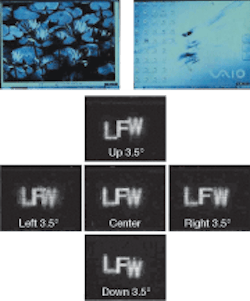3-D IMAGING: Thin integral display switches from 2-D to 3-D

Would a computer monitor or cell-phone display that instantly switches from ordinary 2-D to true 3-D attract the eye of the average consumer? Researchers at Seoul National University, with financial support from Samsung (both in Seoul, Korea), are betting this will be the case. They have developed a type of flat-panel display that can switch from high-resolution 2-D to low-resolution 3-D without requiring the use of viewing glasses or a particular vantage point.1 The backlit display relies on integral imaging to create 3‑D images and optoelectronically switches to conventional 2-D.
While the term “integral imaging” is not familiar to most people, rudimentary integral displays have been found in breakfast cereal boxes for decades. Those little cardboard squares covered with transparent ribs (actually cylindrical-lens arrays) that display shifting views of scenes work via integral imaging, in which each optical element in an array is associated with a tiny but complete image, the sum of which allows changes in perspective.
Due to the nature of integral imaging, electronic integral displays can only produce relatively low-resolution 3-D images. Electronic integral displays have been created before (see www.laserfocusworld.com/articles/218581); however, not only are they large and heavy, but their low-quality images have relegated them to the realm of novelty items. The Seoul researchers dealt with the first problem by developing a thin, lightweight optoelectronic design, and the second problem by a change in philosophical approach. Rather than devising another niche 3-D integral display, they decided to add these capabilities to a high-resolution 2-D display. The potential result: “eye candy” for someone sitting at a computer monitor who, at a keystroke, can call up a true, although low-resolution, 3-D game.
The researchers began with a liquid-crystal spatial-light modulator (SLM) having a 0.036 mm pixel pitch and a resolution of 1024 x 768 pixels (XGA). Rather than using collimated light sources and complicated lens arrays, they combined a conventional liquid-crystal-display (LCD) backlighting unit with a 70 x 70 pinhole array with pinhole spacing of 0.5 mm; each pinhole creates a 3-D pixel.
Switchable pinhole array
Because inserting an ordinary pinhole array would drastically cut the light to the display when operated in 2-D, the researchers created a switchable array by drilling holes in a polarizing sheet and placing it in front of a planar switchable polarizer. Depending on the polarization state, the result is either a pinhole array or a uniformly transmitting sheet. Images in 2-D appear as one would expect on a computer monitor, while the 3-D images change in perspective, as they should (see figure). The resolution of the 3-D images will be improved in future versions, say the researchers, as will other characteristics such as display thickness (potentially a mere 10 mm or so) and light transmission in the 2-D mode.
The SLM used in the first prototype forced monochrome operation. “It is possible, of course, to display in full color by using a color panel,” notes Byoungho Lee, one of the researchers. “Such a system is now under development in our laboratory. There remains one (but not critical) problem of color dispersion in the 3-D mode. However, it will be solved soon and a full-color 3‑D/2-D convertible integral-imaging system using this technique is expected to be realized.”
REFERENCE
1. H. Choi et al., Optics Express 14(12) (June 12, 2006).
About the Author
John Wallace
Senior Technical Editor (1998-2022)
John Wallace was with Laser Focus World for nearly 25 years, retiring in late June 2022. He obtained a bachelor's degree in mechanical engineering and physics at Rutgers University and a master's in optical engineering at the University of Rochester. Before becoming an editor, John worked as an engineer at RCA, Exxon, Eastman Kodak, and GCA Corporation.
